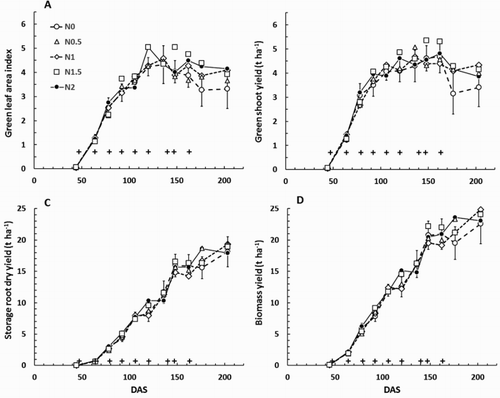Figures & data
Figure 1. Weather observations at the site of Expt 1314 plotted against DAS carrots: A, cumulative rain; B, cumulative thermal time above a base of 0°C; C, cumulative solar radiation; and D, potential soil water deficit (Dø). In A–C, the solid lines indicate the observations for the 2013–2014 season and the pecked lines show the average for the previous 10 years. In B, the crosses indicate the days on which N fertiliser was applied.
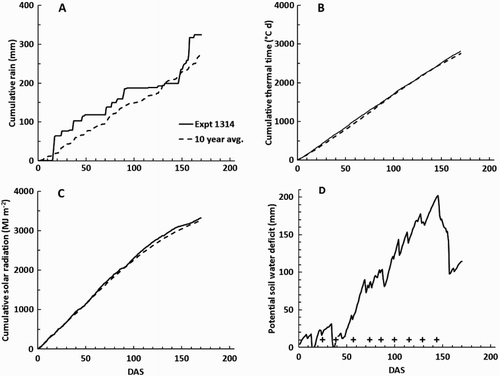
Figure 2. Weather observations at the site of Expt 1415 plotted against days after sowing carrots (DAS): A, cumulative rain; B, cumulative thermal time above a base of 0°C; C, cumulative solar radiation; and D, potential soil water deficit (Dø). In A–C, the solid lines indicate the observations for the 2014–2015 season and the pecked lines show the average for the previous 10 years. In D, the crosses indicate the days on which N fertiliser was applied.
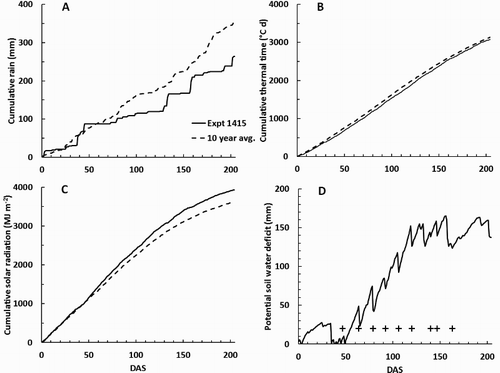
Table 1. Soil chemical properties at the experimental sites.
Figure 3. Carrot plant populations through the season for the 1314 and 1415 experiments. The control (N0) treatment means are shown ± the mean standard error (MSE) from the analysis of variance for that sampling occasion. For any individual occasion, the 95% confidence limit for comparisons between any two means is twice the MSE. Nitrogen fertiliser treatments are described in the text.
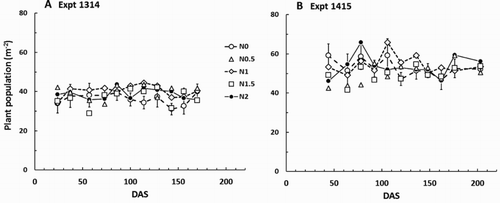
Table 2. Least squares regressions of biomass and storage root dry matter yields (t ha−1) on plant population (m−2) for carrots in the 1314 and 1415 experiments.
Table 3. Effects of nitrogen (N) fertiliser treatments on N concentrations (% dry matter) in process carrots at 156 days after sowing (Expt 1314) and 203 days after sowing (Expt 1415).
Figure 4. Influence of nitrogen (N) supply on N concentration in green leaves (hollow symbols) and storage roots (solid symbols) of carrots: A, Expt 1314 at 156 days after sowing (DAS); and B, Expt 1145 at 203 DAS.
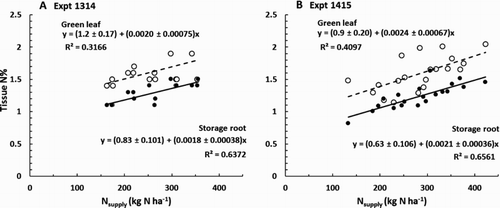
Figure 5. Influence on nitrogen supply (Nsupply) on the net uptake of N by carrot crops in Expt 1314 (at 156 days after sowing (DAS), hollow symbols), and Expt 1145 (at 203 DAS, solid symbols). The plotted line is that for uptake to equal supply.

Figure 6. Carrot crop growth through Expt 1314: A, Green leaf area index (LG); B, Green shoot dry yield; C, Storage root dry yield; and D, biomass yield. DAS = days after sowing. On each graph the crosses indicate times when nitrogen fertiliser was applied. Treatment means for the control (N0) treatment are plotted ± the mean standard error (MSE) from the analysis of variance for that day (using plant population and replicate block as covariates). The 95% confidence interval for separation between treatment means is approximately 2×MSE.

Table 4. Effects of nitrogen (N) fertiliser treatments on the fraction of incident light intercepted by carrot crops in Expt 1314 and Expt 1415.
Table 5. Analysis of variance for fresh storage root yields (t ha−1) of carrots in Expt 1314 and 1415.
Table 6. Analysis of variance for the effects of nitrogen (N) fertiliser treatments on growth and yield of carrots where data have been pooled for all observation dates.
Figure 7. Carrot crop growth through Expt 1415; A, Green leaf area index (LG); B, Green shoot dry yield; C, Storage root dry yield; and D, biomass yield. DAS = days after sowing. On each graph the crosses indicate times when nitrogen fertiliser was applied. Treatment means for the control (N0) treatment are plotted ± the mean standard error (MSE) from the analysis of variance for that day (using plant population and replicate block as covariates). The 95% confidence interval for separation between treatment means is approximately 2×MSE.
